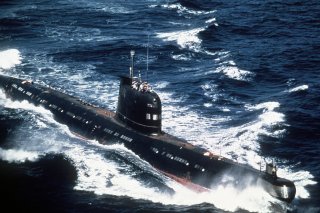Did You Know? This One Soviet Submarine Nearly Started World War III During the Cuban Missile Crisis
The U.S. Navy did not realize the risk of the cat-and-mouse game they were playing with the Soviet subs.
His political officer, Ivan Maslennikov, concurred with the order.
Normally, the approval of these two officers would have sufficed to launch the torpedo. But by coincidence, Arkhipov, chief of staff of the Sixty-Ninth Brigade, happened to be on board—and he was entitled a say. According to some accounts, Arkhipov argued at length with Savitsky before the latter calmed down and ordered B-59 to surface.
As the submarine breached the surface, it was immediately illuminated by searchlights from destroyers. Helicopters and aircraft from the Randolph buzzed B-59 repeatedly at low altitude, firing their weapons across its bow. Destroyers closed within twenty meters, guns leveled, blaring warnings over loudspeakers. The Soviet sub was forced to limp back home.
There is some disagreement over how close Savitsky really came to launching the nuclear torpedo. The nuclear warhead required a certain amount of preparation, and some maintain Savitsky's order reflected a momentary loss of temper under stressful conditions rather than a commitment to following through. Nonetheless, it seems clear that a nuclear exchange was averted for reasons far more circumstantial than any would care to stake the fate of humanity on.
Of the flotilla, only B-4 under Capt. Rurik Ketov was able to avoid being forced to the surface by the U.S. blockade. Although detected by patrolling aircraft, B-4’s batteries had sufficient charge to remain underwater long enough to lose the U.S. patrols. Nonetheless, Ketov too was forced to abort the mission.
Kennedy ultimately moved towards resolving the crisis on October 28 with a secret deal suggested by Khrushchev, in which the United States withdrew missiles in Turkey and promised not to invade Cuba, in exchange for Russia withdrawing its nuclear weapons.
But next time you think of the Cuban Missile Crisis, don’t think first of Kennedy brooding over his options in Washington. Think instead of dehydrated, harassed men trapped in a fragile metal box under the surface of the ocean, trying to decide whether or not to go down in a blaze of radioactive glory.
Sébastien Roblin holds a Master’s Degree in Conflict Resolution from Georgetown University and served as a university instructor for the Peace Corps in China. He has also worked in education, editing, and refugee resettlement in France and the United States. He currently writes on security and military history for War Is Boring.
This article first appeared last year. It is being republished due to reader interest.
Image: A Soviet-built Cuban Foxtrot Class patrol submarine underway. 1 August 1986. U.S. Navy.

